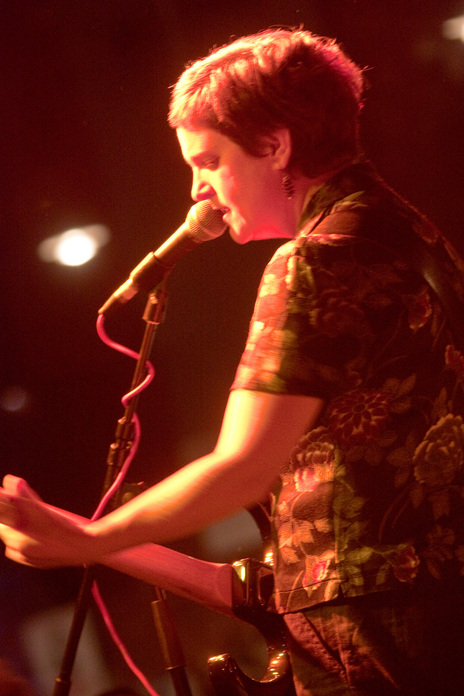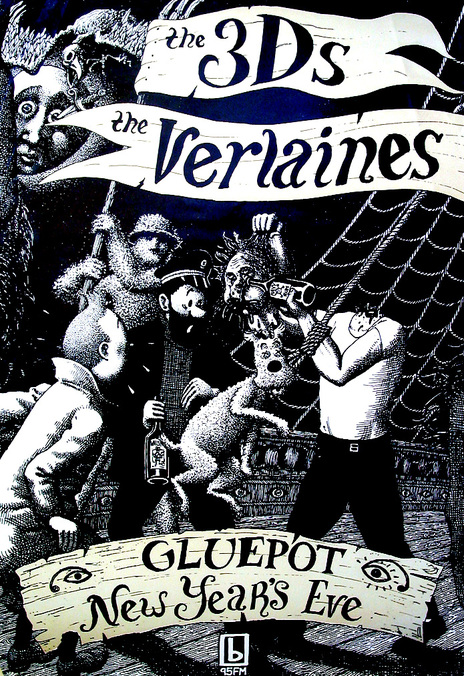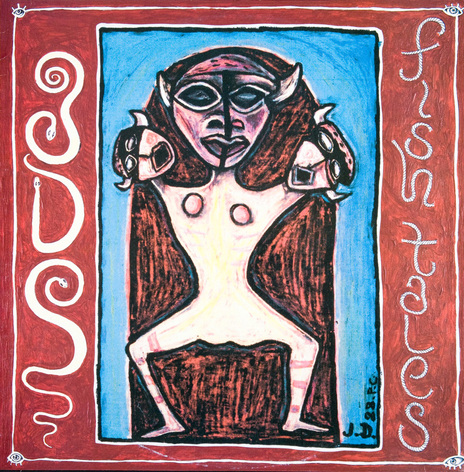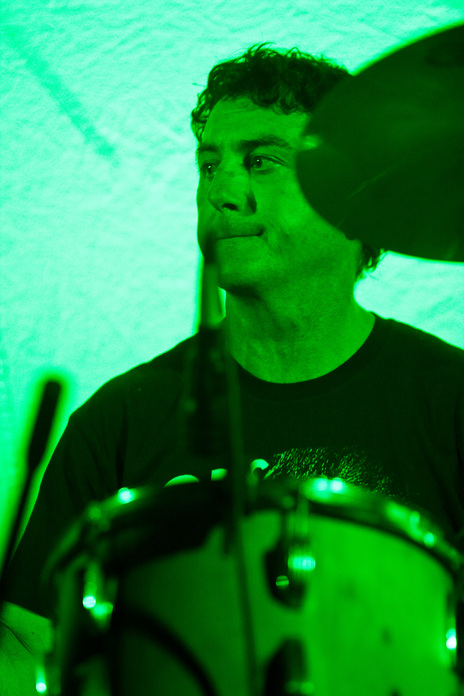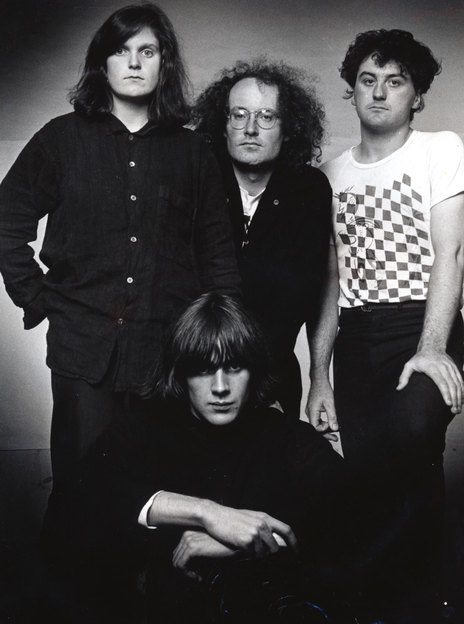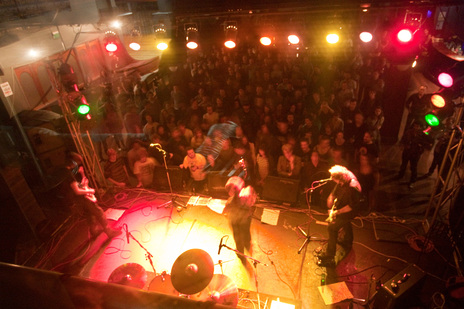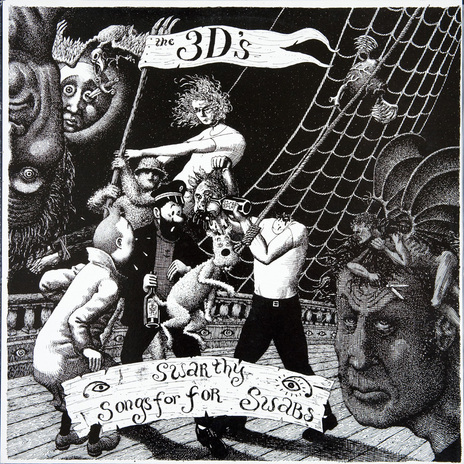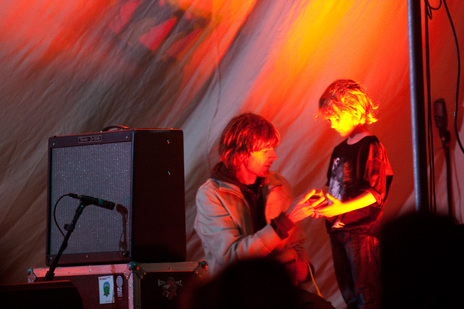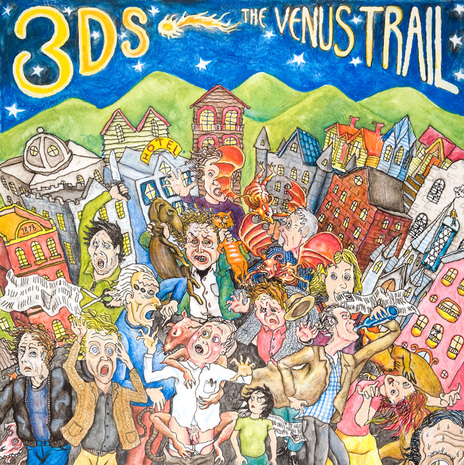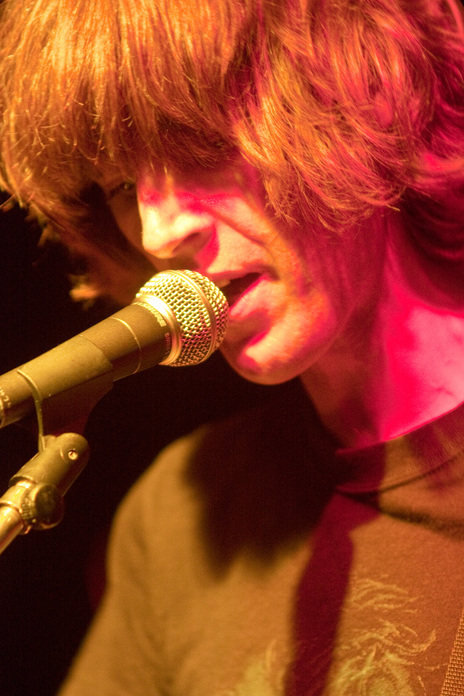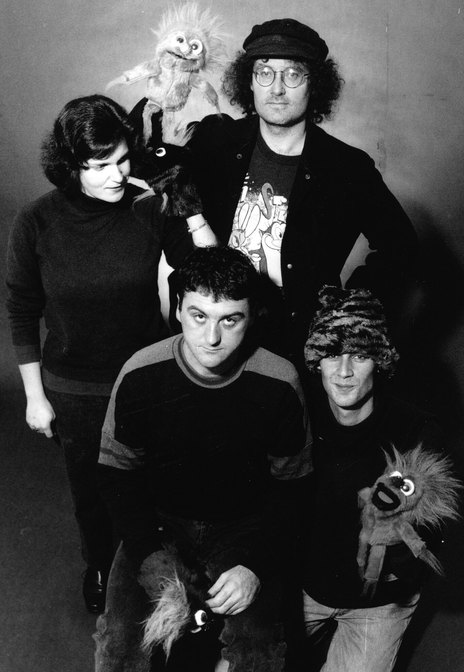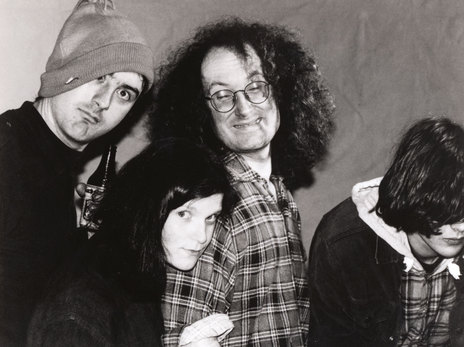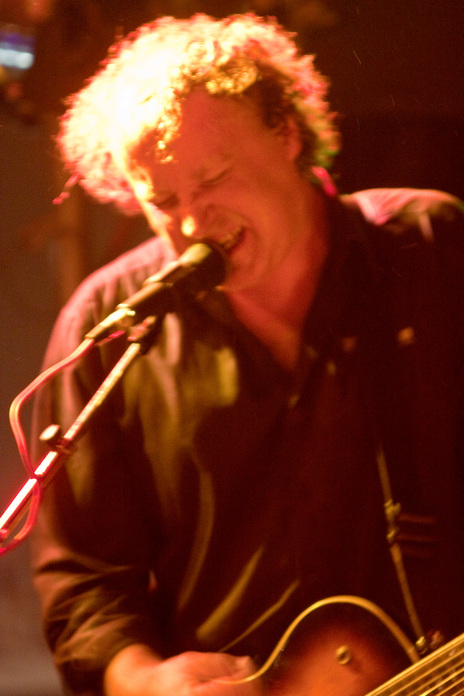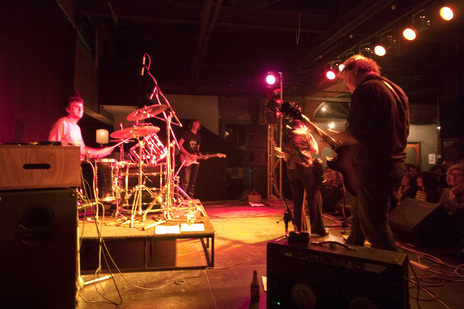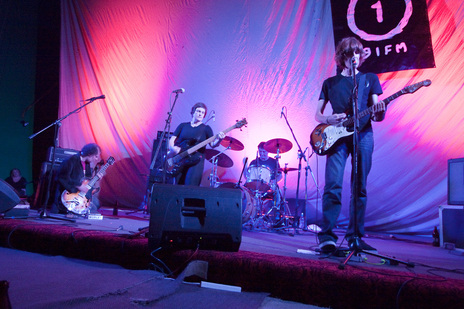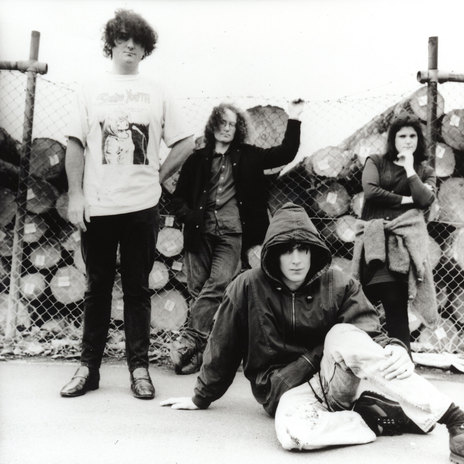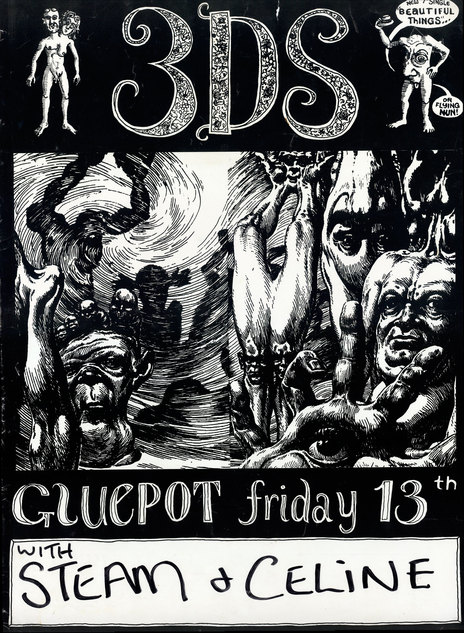Something in the water
The two Davids – Saunders and Mitchell – and Dominic Stones, all young veterans of the Auckland music scene, shifted to Dunedin, that mythical land of cheap rent and endlessly flowing beer. Mitchell told the Otago Daily Times, “The environment of having a city which has a giant harbour you can visibly see from just about anywhere is a lot better for – dare I say it – your soul, than being stuck in an expensive flat in Auckland desperately trying to get together your rent money.”
Stones was nicknamed 'Fatty' as guitarist in Bird Nest Roys – second-wave Flying Nun psych-poppers and the only Auckland band considered part of the mythical 'Dunedin Sound' – and started playing and recording with Snapper when he got to Dunedin.
Saunders had been in the Auckland folk band Battling Strings as a teenager. In Dunedin, he joined The Clean's Robert Scott – with whom he'd been flatting – in a band which illustrates the incestuous warp and weft of the small-city scene: Mr Big Nose, also featuring Alan Haig and Peter Gutteridge from Snapper.
Roughan is the only Dunedin native in the bunch. Her band, the crucial – and remarkably underappreciated – Look Blue Go Purple, had just abdicated after three EPs when Saunders and Stones arrived, and in May 1988 the three met and started jamming.
Stones and Roughan both wanted to be ex-guitarists, and took the drums and bass respectively. Someone noticed they were all named 'D'-something, and that hey! there were three of them! So they called themselves The 3Ds, and lo, they were a band – and it was good.
They didn't set out to be anything more than a good-time band who would play support for other bands, have some drinks and laughs.
They started practicing at Cycle Salvage, a deathly cold motorcycle workshop which let out space to bands in the evenings. They didn't set out to be anything more than a good-time band who would play support for other bands, have some drinks and laughs. In March 1989, the embryonic 3Ds recorded some demos for Flying Nun which were never heard again.
Meanwhile, Mitchell and Saunders had started playing together with Alastair Galbraith and Plagal Grind – and hang on – he was called D-something too! So in early 1989 the fourth D joined the band, and they were called still the Three Ds, but they were even better.
Twin guitars
Before the shift to Dunedin, Mitchell had played in The Exploding Budgies and Goblin Mix. Like a lot of future musicians, Mitchell started as a guitar poseur. His big, bad brother Bob had been kicked out of the house at age 14, and his guitar locked away. Young David found the key, and secretly taught himself to play – jamming on one thumb. Perhaps the union of unconventional learning and this association with evil-doing led to his singular, wiggly guitar style. Likewise his singing voice: a mishap led to broken and replaced teeth, giving him a Tom Rapp lisp along with a bit of a Stephen Cogle warble.
Unlike their twin-guitar forebears Television and Thin Lizzy, the double Davids' twinship must be fraternal, perhaps separated at birth: Saunders’ style raised in a normal loving guitar family, while Mitchell's was nurtured in a nest of serpents. Heard separately, the two guitarists sometimes sound like they are playing completely different songs, like the right hand writing in English while the left hand writes in backward Cyrillic.
Despite their best efforts, The 3Ds very quickly got too good to stay on the side of the stage drinking the main act's beer. In June 1989 they played their first headlining slot at The Empire, one of Dunedin's oldest pubs and a nexus of the Dunedin Sound/Flying Nun/Xpressway scene. At last the beast with three dimensions burst off the screen and into real life (and no need for red-and-blue ear-glasses either).
“The way we seem to work is that we have the rough sort of song charging along and then a great big patch where there’s room for anything."
– David Mitchell
Their set at the time included a number of cover songs, most familiarly Neil Young's 'Powderfinger' and Brian Eno's 'Baby's on Fire' (a recording of the latter was included as the B-side of the Outer Space single). Mitchell told the Otago Daily Times, “The way we seem to work is that we have the rough sort of song charging along and then a great big patch where there’s room for anything. It’s much better for us to be a bit foggy about what’s going on … we put a bit of danger in.”
Fish Street Studios
Bruce Russell started up the Xpressway label the year before, releasing cassettes and 7-inches by the likes of The Dead C and Alastair Galbraith. In fanzine Alley Oop, Russell describes their sound at an early gig (supporting Teeth) as “Horrid little riffs that get under your nails and won’t come out.” Russell encouraged the band to do some recording for his label, at Stephen Kilroy's newly founded Fish Street Studios in the Dunedin wharf-side, where Kilroy was re-building a massive old eight-track recorder. They shifted into Fish Street as their new practice space and recorded some demos on Mitchell's four-track while Kilroy tinkered.
Flying Nun
The deal with Xpressway was shortly foiled by lack of funds, and the band was scooped up into the Flying Nun net. In April 1990, they recorded their first EP, Fish Tales, with Kilroy and imported Auckland engineer Matthew Heine (of Spud) at Fish Street Studios. Awaiting the release of this debut, they began their first tour of the country. Later that year they were back at Fish Street to record their second EP (or "Mini-Album", as these were sometimes called at Flying Nun), Swarthy Songs For Swabs, with Kilroy and new engineer Tex Houston, who would continue his association with the band until the end.
Songs from this early period, like 'Mud Sacrifice' and 'Ritual Tragick' hint at Mitchell's fascination with the occult, first heard on his song for the Exploding Budgies, 'Kenneth Anger'. But creepy was only one of their bags. 'First Church' is a soaring fantasy of flight, 'Meluzina Man' is dazzling melancholy, and 'Dreams of Herge' is droney, distorted, literate and catchy.
In February 1992, The 3Ds (along with Second Child) supported Nirvana at the Logan Campbell Centre in Auckland – just as Nirvana became the biggest band on the planet following the release of their Nevermind album and 'Smells Like Teen Spirit' video. Nirvana offered The 3Ds a support slot for their tour of Japan, but they declined. They had recorded their first full-length CD (not issued on vinyl until 2011), Hellzapoppin, at Fish Street Studio in late 1991, and made their first trip overseas for a short US tour to promote the album release, opening for bands like Superchunk (who gave the good word to their label Merge, and got The 3Ds a record deal), and playing at the CMJ New Music Seminar in New York.
Classic albums
Hellzapoppin gives a name to the congenitally bipolar sound of The 3Ds. It’s pop music, sure – but it’s debauched. There are simply-structured upbeat pop-rockers with oblique, hallucinatory lyrics, and there are deceptively sensitive songs about absurdly horrible things. Two songs back-to-back on the album describe this dichotomy: ‘Leave the Dogs to Play’ and ‘Hairs’ define the difference between Saunders’ sunshine and Mitchell’s scunge-slime. It’s not so much a division – it’s there if you look for it, but Saunders can get scuzzy, and Mitchell likewise warm and fuzzy.
Their follow up, The Venus Trail, is the ecstatic crest of The 3Ds adventure. That noise/pop tension found its harmony, and gave the international scene a wallop. The 3Ds had absorbed as much as they delivered to what was now firmly called "Alternative Music", and that give-and-take is all over this album. As much as big single and album opener 'Hey Seuss' ubiquitously insinuates The Pixies, Roughan's organ sweeps are straight-up Enzed. 'Philadelphia Rising' is a perfect grunge classic – even as it references a city on the opposite coast from grunge HQ, and a million miles from Dunedin.
Elsewhere one can hear the psych-rock sludge of contemporaries like Gish-era Smashing Pumpkins, and jumped up atonal pop of Sonic Youth's Goo. Even Psalm 69-era industrial-metallers Ministry are in the mix, with a buried sample in the scuzz-thumper 'Man On The Verge Of A Nervous Breakdown'. The radiant sadness of Roughan's and Saunders' vocal harmony on 'Young And Restless' would fit in the Yo La Tengo fan's iTunes mix, while 'Beautiful Things' is nearly a track by Roughan's old band Look Blue Go Purple. While it's still grittier, one almost expects Norma O'Malley to break in at any moment with an eddying organ fill.
Rumour has it that The 3Ds were bringing in said suds by the pallet-load, which led to a South Island shortage of the beer.
The Venus Trail was recorded at Dunedin's Grand Masonic Lodge (No.931), which was built in 1864 as a synagogue and later deconsecrated and converted to a Masonic temple. More recently it was the Temple Gallery, and in 2004 it was used again for recording The Chills' Stand By EP. As so many of The 3Ds' own stories of their early days seem to revolve around drinking and having a good time, it's no surprise the liner notes to this album give a "special thanks to Mac’s Ales." Rumour has it that The 3Ds were bringing in said suds by the pallet-load, which led to a South Island shortage of the beer.
In 1993, U2 came to New Zealand for two stops on their Zoo TV “Zoomerang/New Zooland” tour. Bono asked for The 3Ds (along with Big Audio Dynamite II) as the opening act for their shows in Christchurch and Auckland. The story goes that "an associate" of The 3Ds stole a bottle of wine from the Irish super-band's dressing room, and The 3Ds were told by the promoter that the band would not get paid for their set. Bono, magnanimous as ever, insisted The 3Ds were paid – in fact, let’s make it double – and that they receive an extra bottle of wine.
International recognition
The band left for a tour of Australia and the USA (with Superchunk, Pavement and Guided By Voices), and to the UK, where they recorded three songs from Venus Trail and a track from Swarthy Songs... for a Peel Session on 24 April, 1994. They got both Band of the Week in Melody Maker, and Album of the Week in the NME. Returning to NZ, they took Pavement and Superchunk on tour both at home and in Australia, and in 1995 played all legs of the Big Day Out Festival. Later that year they returned to Fish Street (now incongruously located on Burlington Street) to record their first new records in three years, the EP Caterwauling and final full-length Strange News from the Angels.
Stranger times
Strange News from the Angels was an unsatisfying finish for this world-class act, a sombre, restrained album that featured no guest musicians and no vocals from Roughan. The album is filled with finely-crafted, lusciously produced and bloody fantastic songs, but perhaps the fairest criticism was that Strange News... was more of the same, but somehow less of the same: It sounded like The 3Ds we loved, but also a bit too much like a lot of other bands. It's the mature sound of a band who have been together a while now, played the big gigs, and know all of each others' gifts, quirks and faults.
In hindsight, it's easy to read it as a slightly exhausted final report just before retirement. In a 1996 interview in the Otago Daily Times, Mitchell was less than his usual effusive, ebullient self when he described the album as “a mixed bag” with a “melancholic feel”. Like surfing on a heavy Dunedin winter swell, Strange News... is filled with the merry melodies and munty muck of their previous works, but somehow submissive, bowed under its own weight. The early experimentalism found in tracks like ‘Teacher is Dead’ (from Hellzapoppin) was given over to a more systematised 3Ds sound.
The photographs of gravestone angels included on the CD artwork were either foreshadowing or an outright message: In 1997, the 3Ds chucked it in. Saunders told Australian music magazine Mess and Noise, "By 1997 I guess we had done all we really set out to do. We never imagined we would go as far as we did ... and it started to feel like we were going to imitate ourselves. So we just stopped, there were no 'words' or a big argument, we just ended a tour and didn’t book any more shows. I mean, if it’s not fun, why do it?"
I mean, if it’s not fun, why do it?"
– David Saunders
New beginnings
After the end, Roughan and Mitchell moved to London, and began recording together with Jim Abbott as Ghost Club, named after a 7-inch single they’d recorded together for Flying Nun in 1996. They released Ghostclubbing in 2002 and Suicide Train in 2006. Roughan joined MarineVille in 2009 and Mitchell recorded solo material under the name Leather Apron in 2005.
The 3Ds played a few reunion gigs in 2009-10 for the 20th anniversary of Merge Records, the All Tomorrow’s Parties festival, and selected shows in New Zealand and Australia.
